
AQUATIC LIFE AND BRITISH VICTORIAN MICROSCOPY
Peter B. Paisley
Sydney, Australia
Article in 'doc' format for easier printing. (9 Mbytes)
Diatoms
Around 1857 a commercial mounter complained to John Quekett that he “had exhausted the animal kingdom” (as reported to Frank Buckland). The unnamed mounter perhaps was John T. Norman: mentioned in Quekett’s books, his firm possibly had the most prolific output of any of those named (the list included Topping, Poulton, Darker and Bond). Preparers like Norman or Topping made a plethora of duplicate mounts, intended for amateur enthusiasts and medical students and, as the century wore on, targeted burgeoning numbers not only of medical students but also of zoology and botany students. The remark to Quekett may imply some ennui: if so, the enormous variety of diatom forms offered ample opportunity to relieve any boredom. The commercial mounting industry was not alone in savouring diatom variation – by 1857 William Smith built an academic career largely on the study of these tiny organisms, and claims for first discovery – hence perhaps eponymous fame – provoked many disputes in the literature. By 1840, Ehrenberg’s observations on fossil diatoms, to quote one popular encyclopaedic work, had already “caused a great sensation in the philosophical world” (supplement on microscopic discovery to Goldsmith’s Animated Nature). Diatoms yielded endless diversion: easy to obtain, they required little equipment compared to other subjects. Enthusiasts found that pools separated by mere yards contained different diatom populations - important to forensic police, to this day. Long summer evenings, or weekends all year, offered dual opportunity for pleasant strolls and gathering of microscopic material. Even large cities provided such pleasures, in quasi-rural surroundings: the slides shown below, made by unknown preparers, illustrate the point for London and Belfast.

Diatom slides, with material from favourite recreational areas- Belfast’s Lagan canal walks and London’s Regent’s Park
As Bracegirdle comments, diatoms provided a large industry in mounting, which reached something of an apotheosis in Möller’s production of slides with hundreds, then thousands, of different forms. From the start, Science Gossip contained reports on diatoms in nearly every issue. Academic investigators and members of microscopical clubs kept the pot boiling throughout the nineteenth century and beyond.
Marine material
Early in the century, it was commonly supposed that seas contained no life beyond comparatively shallow depths. This “azootic theory”, championed by Edward Forbes, was more or less finally put to rest by Wyville Thomson’s results from the Lightning and Porcupine voyages, publicised in his The Depths of the Sea in 1873. Material from these voyages soon appeared on slides by both amateur and commercial preparers.

Slides of marine material: Wheeler, and the amateur mounter William Wake made the Porcupine mounts. “Greenpapers”, a prolific but as yet unidentified commercial mounter, may have used Lightning material for the middle slide shown.
Already by 1850, Thomas Henry Huxley had completed his voyage on the Rattlesnake, and in 1859 his observations on oceanic hydrozoa (after many disputes on financing) were published, sponsored by the Ray Society.
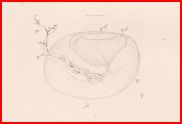
Sphaeronectes Köllikeri, drawn by T.H. Huxley: like many anatomists both macroscopic and microscopic, he was an accomplished draughtsman. The slide by Wheeler below, dated 1856, used material from another voyage around that time.
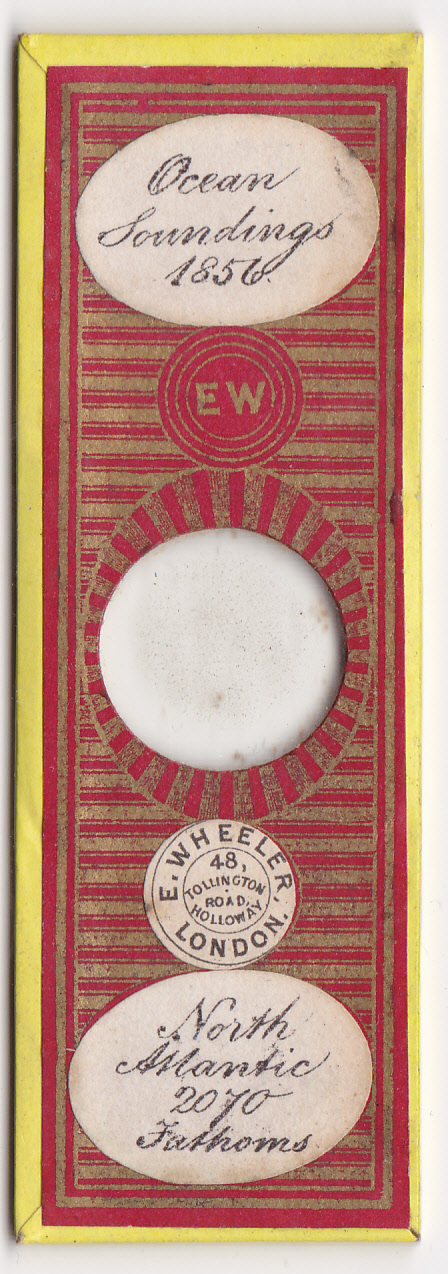
Microscopic marine organisms became increasingly favourite subjects for mounters and slide collectors alike. The huge interest is illustrated by the large number of surviving slides, for instance, of polycystina from Barbados (although why this island was favoured above any other in the region is something of a mystery to this writer).
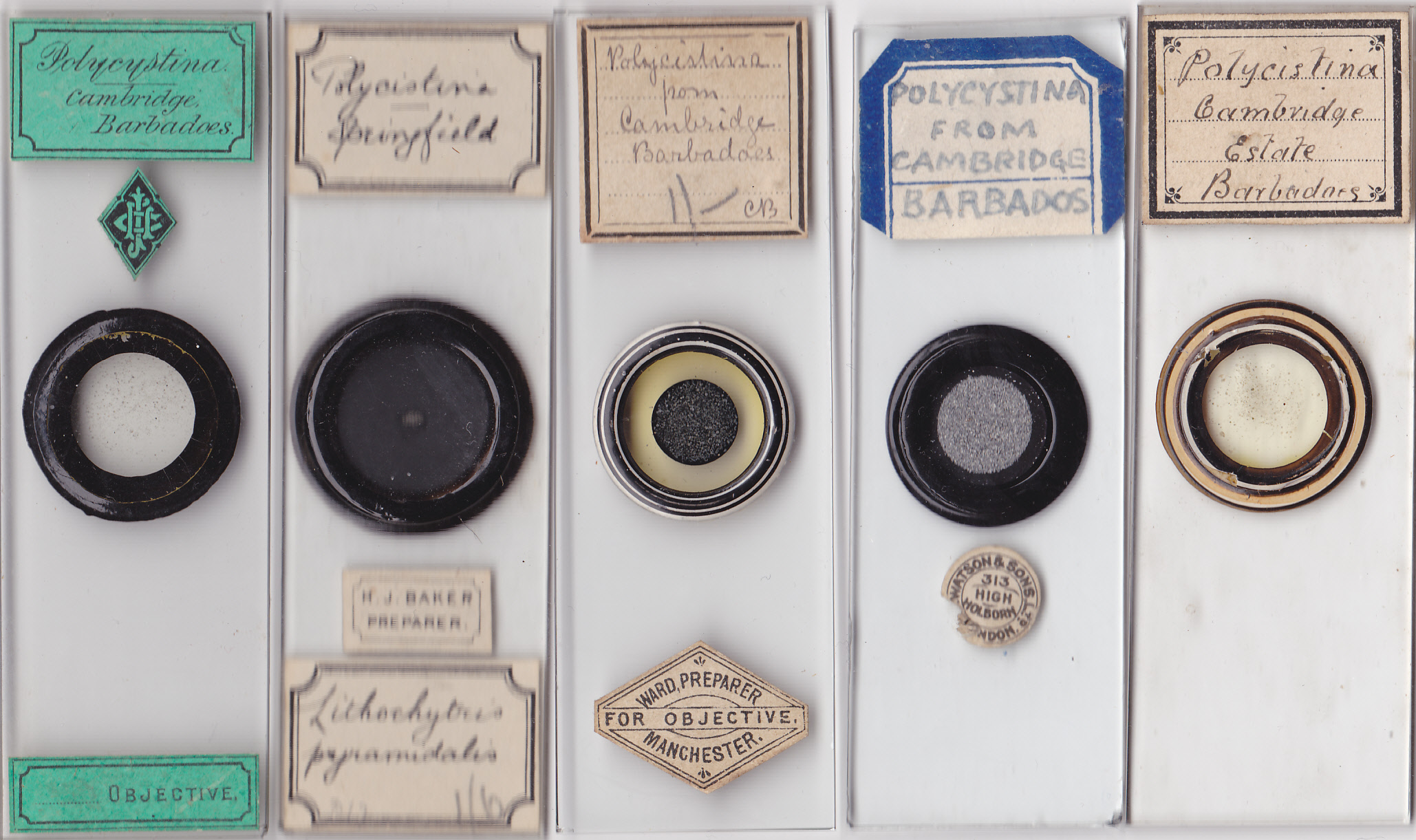
A few examples of the subject favoured by so many Victorian mounters – polycystina from the ever popular Barbados
Any ship which threw down a dredge net might turn up new forms for microscopic examination, and many ships did. Private yachts, cable laying ships, naval vessels – all contributed.
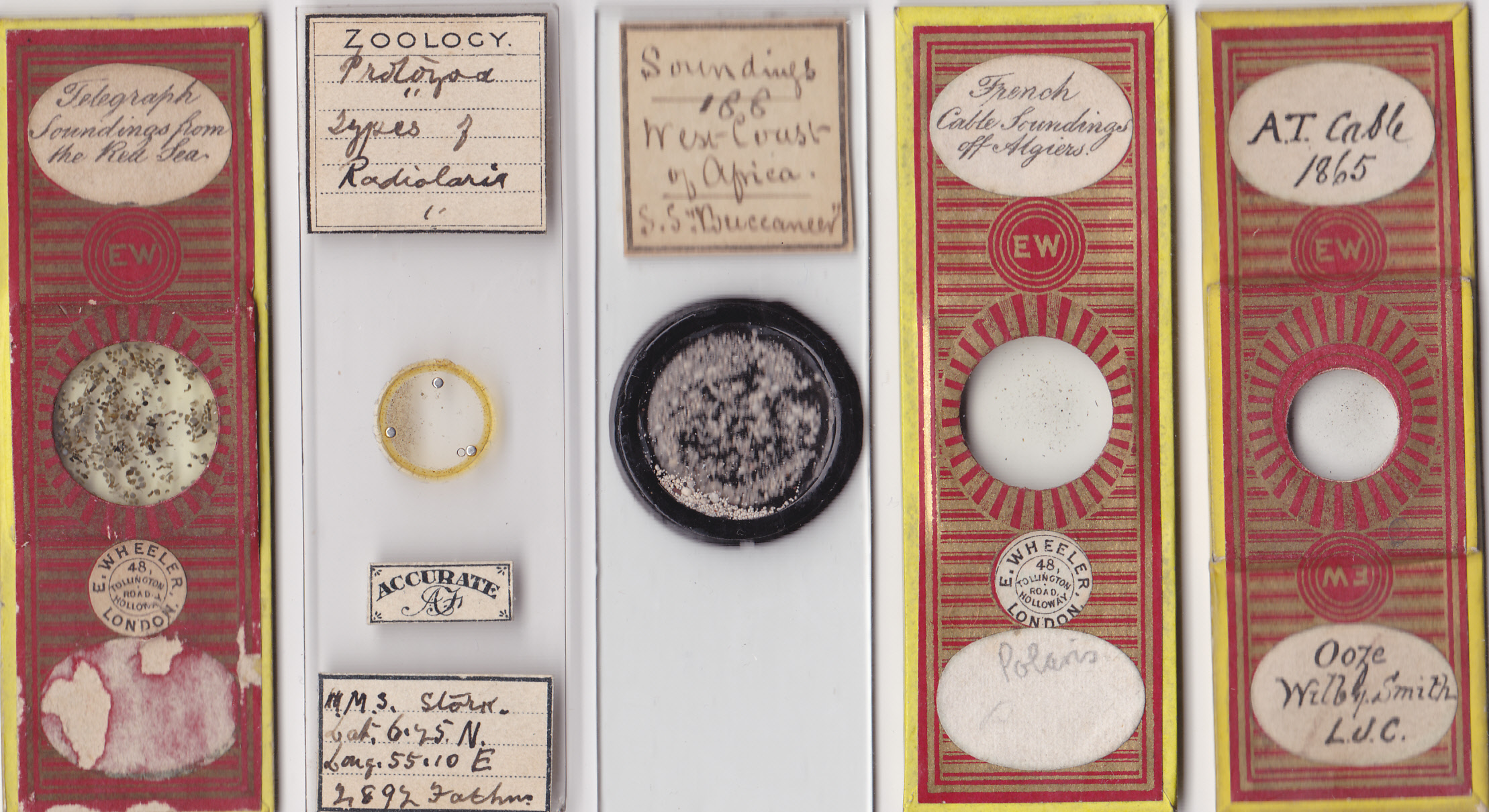
Whatever the primary purpose of a voyage, any ship might provide material for preparers.
A voyage might only secondarily include hope of new biology, but some expeditions were particularly so designated: results of their searches stimulated interest far beyond the confines of academia – Darwin’s Beagle Journal made him a best-selling author long before publication of The Origin of Species. For commercial mounters, there were incentives to prepare new material, given plenty of customers eager to view it. If enthusiasm for new diatom species waned (and it never seemed to) mounters could turn to making arrangements, producing elaborate “exhibition slides” to delight the eye of collectors – prices for such slides reflecting this greater artistic novelty. Arranged diatoms could only be appreciated via microscopes, but arranged foraminifera and polycystina could be attractively eye-catching to the unassisted gaze of potential buyers. No wonder prospects of new polycystina or foraminifera proved exciting for any commercial mounter.
Diatoms however continued as a dominant interest: by the 1870s, at least one mounter – W.A. Firth – was commercially successful almost entirely based on their preparation: others with wider scope like Topping and Barnett had long been making dozens of slides of specific diatoms. Arthur Cottam, a London civil servant, made many mounts (doubtless informed by tuition from his cousin Arthur Cole): judging by the number of surviving slides, he devoted most of his free time to diatoms.
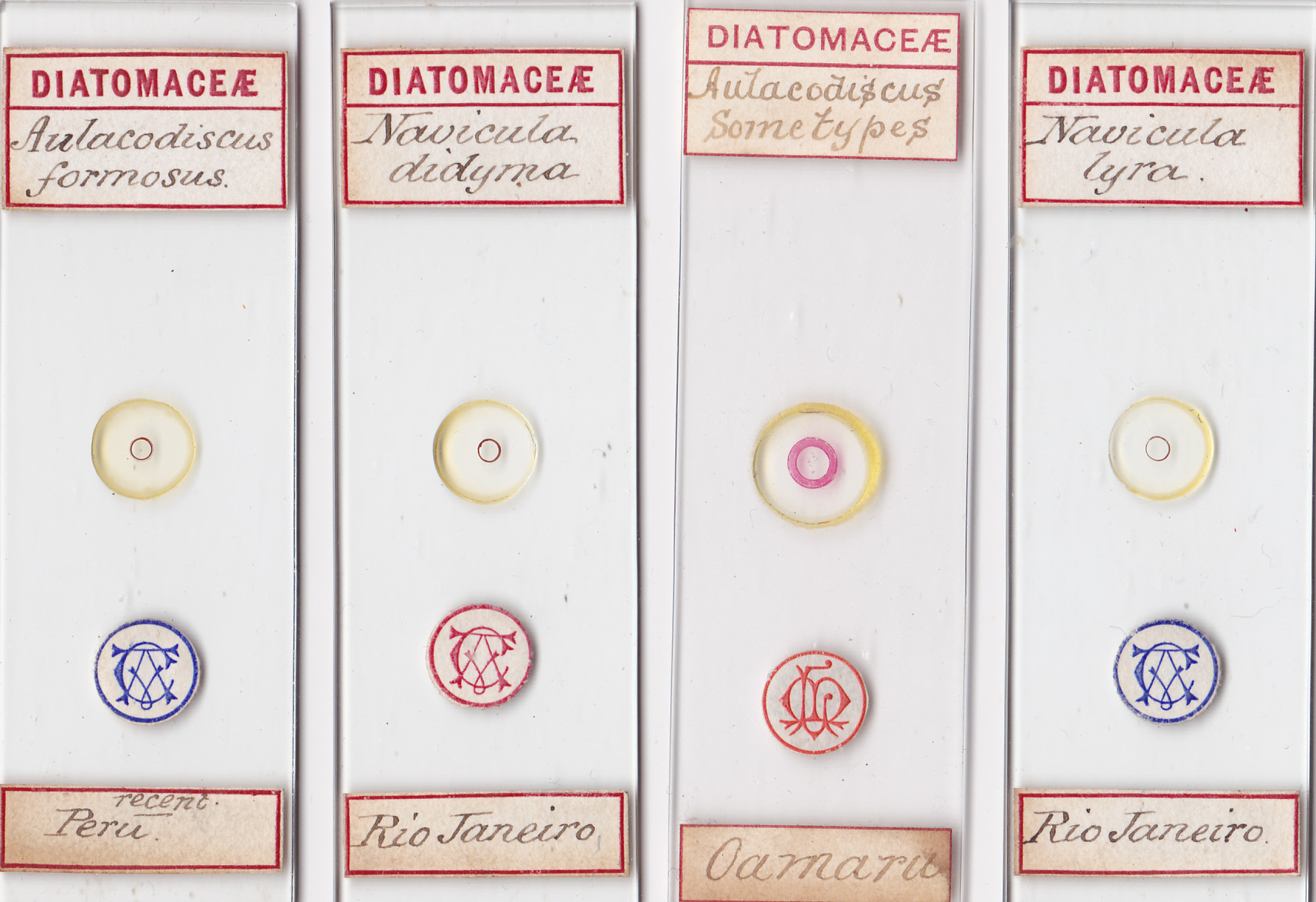
Some Cottam mounts: an amateur perhaps, but nonetheless an expert mounter and taxonomist
The Challenger voyage and popular interest in science
Led by Wyville Thomson, like the previous voyages of the Lightning and the Porcupine, the Challenger expedition was by far the most comprehensive scientific undertaking of the age.
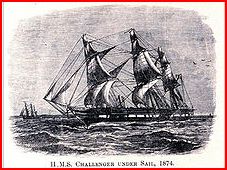
While few microscope enthusiasts had seen HMS Challenger, the public became widely familiar with her appearance through books such as those by Spry and Moseley. The impact of her voyage was great, notably on geology, hitherto deficient in knowledge of ocean floor formations, but biological finds in the end stimulated most general interest. Publication from the voyage was enormous, comprising 50 volumes initially and then a vast secondary literature. That however did not immediately follow completion of the voyage in 1876. Thomson seems to have suffered repeated bouts of depression, and resigned in 1879, leaving oversight of publication to his colleague John Murray. Meantime the naval captain of the Challenger, William Spry, achieved popular success in 1877 with his journal of the voyage, and one of the naturalists on board, Henry Moseley, “did a Darwin” in 1879 with his account. The general community, including myriad amateur microscopists, had been agog with interest from the start, long before Spry’s book appeared. This interest is obvious in the columns of Science Gossip, which reported the Challenger’s progress with frequency. Any commercial mounter laying claim to sole rights to Challenger material might be in for a killing: possibly J.T. Norman harboured such ambition, judging by his 1880 advertisement, below.
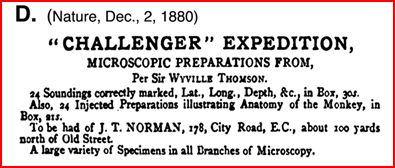
Any such hopes however seem doomed by the findings of the 1875 Royal Commission on copyright, which inter alia pronounced that:
“The law is wholly destitute in any sort of arrangement,incomplete, often obscure, and even when it is intelligible upon long study, it is in many parts so ill-expressed that no-one who does not give such study to it can expect to understand it.”
Not exactly encouraging, for any commercial preparer seeking exclusivity. In any case, it would have been difficult to sustain copyright claims for slides carrying mounts of life invented by God, or produced by blind natural forces, depending on one’s point of view. Barnett made slides of Challenger material soon after the voyage ended (an example recently sold on eBay), and many others subsequently did so. Of course, naturalists on board the Challenger and other vessels made slides for their own research reference, never intended for other use. A collection of Wyville Thomson’s slides recently sold at auction in Bristol, and occasional Thomson slides still find their way to on-line auction sites. Thomson and Norman may have had some kind of “gentlemen’s agreement” on use of Challenger material, but Thomson’s retirement presumably opened floodgates for other mounters, both amateur and professional. Thomson’s successor Murray certainly supplied some to a collector in Bath, as shown below, and many preparers both amateur and professional made mounts. With so many involved in analysis of the Challenger results, “leaking out” of material for mounters was well-nigh inevitable.
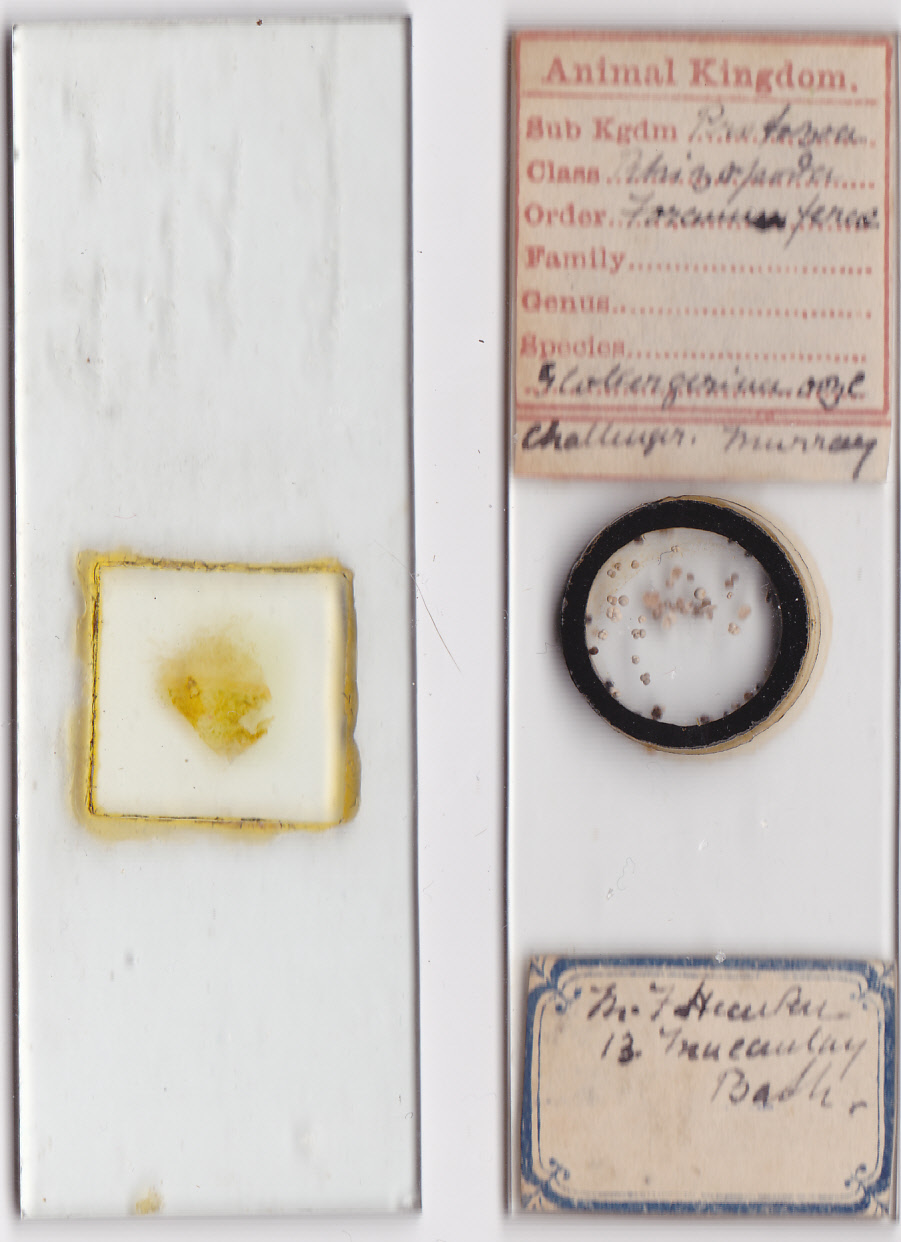
Challenger slides by Thomson, and with material supplied by Murray

A plethora of preparers: the six slides above are only a small sample of slides made by both amateur and commercial mounters. The Norman slide on the left, with its stylish tapered glass, perhaps echoes ambitions for rights.
Apart from the ever abundant diatoms, Challenger findings included many new organisms, which fuelled Darwinian evolutionary debates. The arch-Darwinian supporter of natural selection determinism, Ernst Haeckel, published papers on some of these, and later used them to support strongly materialist arguments in his beautifully illustrated books. The Challenger discoveries thus had considerable impact on expanding evolutionary discussion into the realm of microscopy, hence stimulating interest among members of microscopical societies all over Britain and providing an eager market for commercial slide makers. “Pond life”, a favourite study of microscopists since the seventeenth century, by the late nineteenth had gone oceanic and global.
Artistic opportunity
Since the Renaissance, European art featured still life, both as inclusion in portraits and altarpieces, and as a genre in its own right. Arranged slides of diatoms, polycystina and foraminifera constitute what is essentially a branch of such art in miniature. This is scarcely surprising, since the pages of periodicals like Science Gossip or the Journal of the Postal Microscopical Society contain many examples of excellent artistry by amateur mounters. Professionals were not slow to follow the trend with their “exhibition slides”, and collectors were willing to pay high prices for these. Suter for instance in 1900 charged fifteen shillings for a “type slide” of sponge spicules, compared to his run of the mill mounts ranging from ninepence to two shillings.
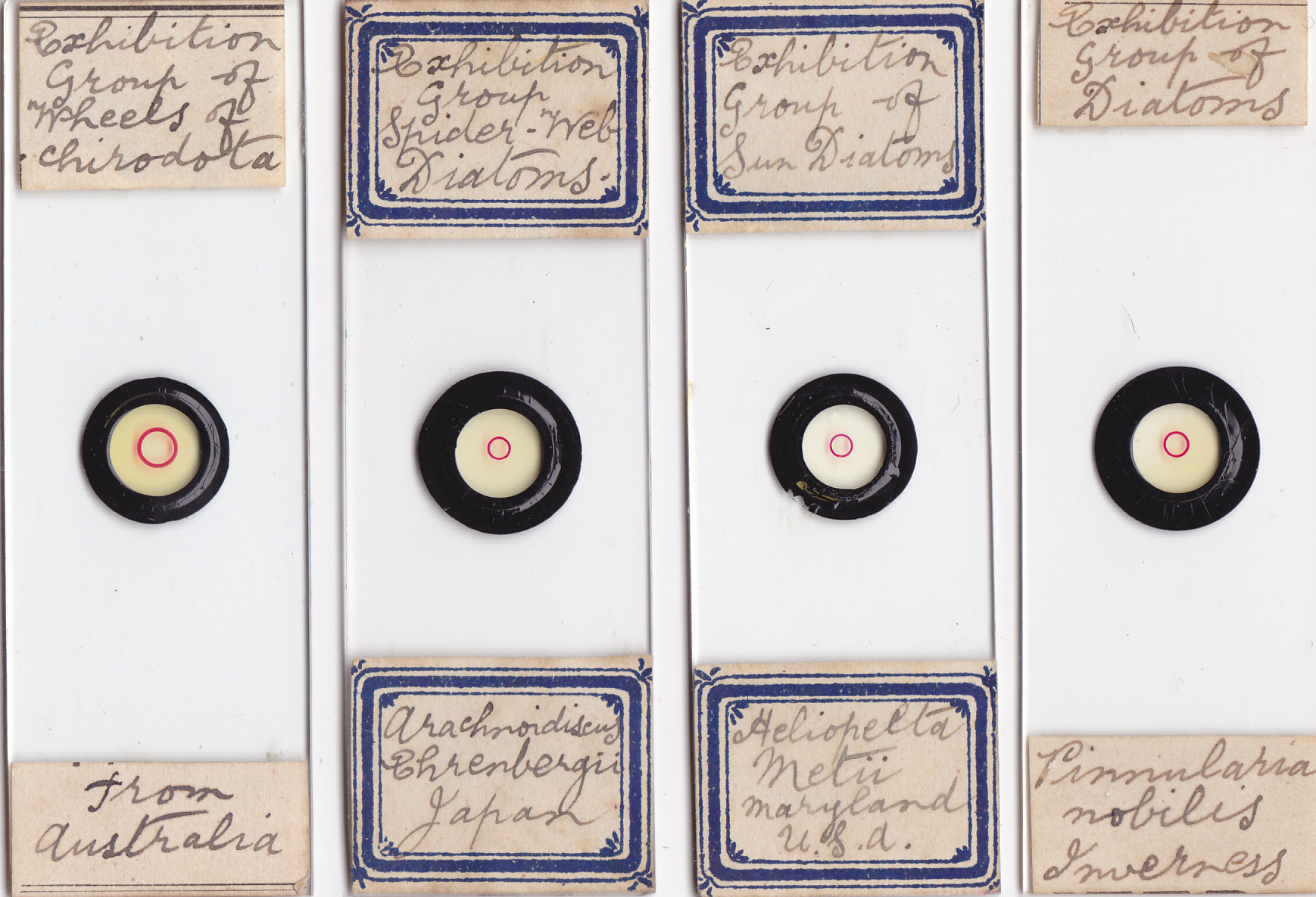
Suter exhibition slides: despite high prices, the demand must have been substantial. The slides here were made when their mounting outran his supply of printed labels.
Many saw oceanic organisms as works of art in themselves, and commented on this. The most spectacular expression of the attitude is found in the work of Ernst Haeckel, who – already an expert – worked on some of the Challenger material. His drawing of a dinoflagellate captured on the voyage is shown below.
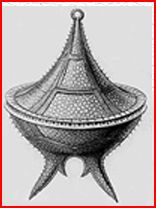
Haeckel was heir to Germanic naturphilosophie, notably exemplified by the work of Goethe, whose writings dealt not only with biology but also with aesthetics, art theory and colour perception. Haeckel continued the extensive research on aquatic forms already done by von Kölliker and others: he was not only accomplished with pen and ink, but a highly accomplished artist in water colours and oils. Marine organisms were a major source of inspiration, as exemplified in his book Kunstformen der Natur (1904), from which an illustration is shown below.
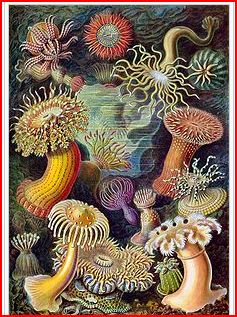
Sea anenomes (1904) by Haeckel
His home in Jena – the “Medusa house” – had lavishly decorated walls and ceilings, with fanciful combinations of such creatures: the overall effect anticipates the surrealist compositions of Salvador Dali, but (in my opinion) Haeckel was the more technically accomplished painter. Today, prints of his works sell for $50 upwards - offered as art rather than science, although they can be appreciated for both.

A Haeckel print currently offered for sale on the internet – many dealers have them for sale, in profusion.
Haeckel is exceptional: in a less spectacular way, many amateur and commercial mounters produced not inconsiderable artistry in arranged preparations. Early microscopy included observation of ice crystals, with their kaleidoscopic variety of geometric shapes. The advent of photography enabled these to take on visual permanency, impossible on a slide, and such images were popular, appearing in books as drawings before photography took over. The arranged polycystina below would have struck immediate aesthetic chords in customers. With added artistic merit came increased commercial potential: interpolation of lenses was not needed to see the appeal of such mounts.
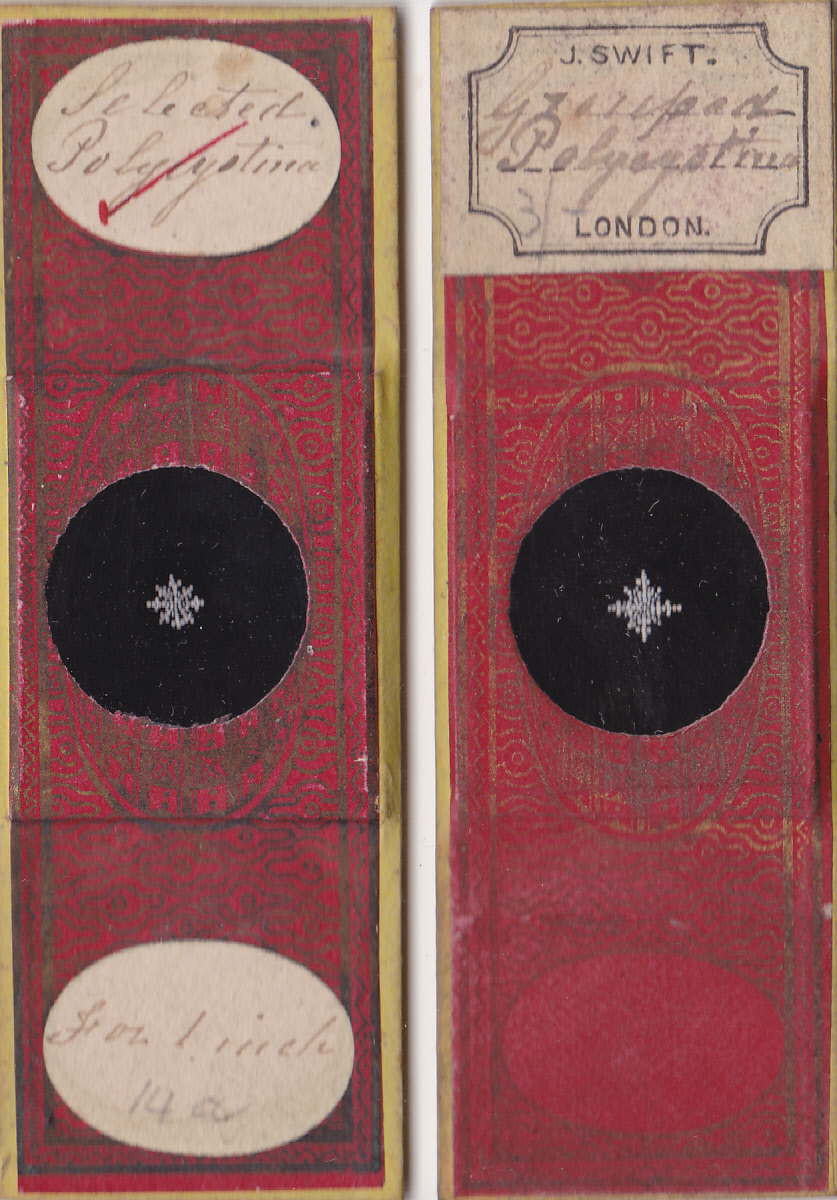
What prospective buyer, prepared to spend a little extra, could resist these exquisite Topping presentations?
The regular contributor to the Postal Microscopical Society’s publications, Tuffin West, was also a gifted illustrator: as well as in his regular articles, his work appears in many books, like those by Jabez Hogg.
Symmetries and patterns in nature were philosophically interesting to microscopists - theists and materialists alike. Whether or not the viewer included any creationist dimensions in his or her appreciation of the wonders of aquatic life, the explosion of knowledge of it in the Victorian era greatly enlarged possibilities for its microscopic scrutiny.
Ruling the waves
Having teetered on the brink of republicanism, with the monarchy at a nadir of unpopularity, on the accession of Queen Victoria Britain abandoned such sentiments and found itself on the crest of a new wave of royalist imperial fervour. The industrial revolution, running at full throttle, required inventiveness and improved engineering to keep imperial wealth going. Engineers were elevated to the rank of heroes by authors like Samuel Smiles, in Soviet- Russian-like style. The Great Exhibition of 1851 celebrated Britain’s achievements in every technological area – not least microscopy - and was attended by enormous crowds. Underlying all the hubris was the conviction that basic scientific research was needed for Britain to stay ahead of her competitors. Microscopes, and slides, were prominent among the displays again at the London Exhibition of 1862.
As a superpower, Britain had long relied on naval force to maintain the flow of riches from a global empire: where better than the navy to turn for new discoveries from distant parts? The ruling élite had a growing appreciation of “pure” research as a possible source of economic and military advantage, something already sensed by another emerging maritime superpower, Germany, a fact well emphasised by Prince Albert. Britain had better rule the waves with dredge nets as well as naval artillery. The Lords Commissioners of the Admiralty, in 1849, produced a Manual of Scientific Inquiry prepared for the use of Her Majesty’s Navy, under the guidance of Sir John Herschel. Henceforth, what had been done sporadically would be an increasingly systematic matter of strategy. For the navy, improved charts required better knowledge of sea floor geology, and one “spin-off” was extension of marine biology.
Apart from profit from fishing however, any economic trickle down effect of increased biological knowledge gained via microscopy, like Huxley’s studies, was not at once obvious. In academia, biology for its own sake was initially the poor relation among sciences. It is startling to recall that when Huxley started his career, Britain had not one university chair in biology: but by the time he retired there were more than fifty. The difference, of course, was largely created by debates over the principle of natural selection, which threw a spanner in the works of both taxonomy and theology, shaking supposedly unassailable belief systems to their foundations.
Did any of this disrupt observational attitudes among the community of microscopical enthusiasts? Probably not much: diatoms and other minute organisms could be discussed objectively by investigators, whatever their taxonomic or religious convictions, and the same was true for those other favourite objects of study, the insects- whose larvae were often also included in aquatic studies. Writing in November 1865 for Science Gossip, the Rev. L.G. Mills ended an article on insect spiracles thus –
“The above afford instances of the general conformity to system so prevalent in Nature, with those deviations in minor detail which, so far from being discrepancies, are among the harmonies of Creation”.
These are the sentiments of a natural theologian, but if they are excised, the foregoing article could equally well have been written by an atheist - the microscope was an efficient instrument for stripping preconception from observation. Discussion of apes might provoke indignation in creationists, but polycystina were unlikely to arouse similar passion. Microscopical marine organisms however could and did produce seemingly unlimited new delights for amateurs and academics alike. Warships could gather material as well as merchant vessels, and it was no coincidence that, as the Victorian era wore on, a major volume of learned literature on oceanic life came from the rival naval powers, Britain and Germany.
Moral improvement
The industrial success of Victorian Britain had its dark side, criticised by authors like Dickens and Thackeray, and observed with horror by foreign analysts like Engels. Social evils were deplored by moralists, but working class conditions often seemed to leave little affordable solace beyond overindulgence in alcohol. Practically minded reformers sought alternatives: gardening, for instance, was much extolled as a cheap healthy alternative to keep working men out of the pubs - the redoubtable Mrs. Beeton wrote her Book of the Garden as a companion volume to her better known advice on household management. Many such books however were aimed at the well off middle class, and something more affordable for “ordinary” working men (and women) was championed by advocates of microscopy. The great proliferation of clubs, where members pooled resources, allowed access to good instruments by almost anyone; individuals, increasingly, could afford their own apparatus at home, as economies of scale made efficient instruments cheaper; and, later, various clubs – notably the Postal Microscopical enterprise of Alfred Allen – facilitated exchange of slides between members. Moral reformers were quick to see the opportunities.
An island nation with long coasts offered obvious intellectual stimulus in littoral marine biology, combined with healthy outdoor activity. Expansion of railways brought the coast within easy reach, and an already favourite holiday destination – the seaside – saw mass summer exodus from big industrial population centres. Unfortunately – in the view of that indefatigable muscular christian, Charles Kingsley – the lemming like rush too often led to sunlit stupor, with “….interminable reading of the silliest novels”. For young men, he grudgingly admits, this “keeps them out of the billiard-room”: but, alas, after such mindless days, the evenings degenerated into “a soulless rechauffé of third-rate London frivolity”. How much more elevating, then, to “try to discover the Wonders of the Shore” and – of course – contemplate “a world like this, about the making of the least part whereof God has employed ages and ages, further back than wisdom can guess or imagination picture” (writing this in Glaucus in 1855, Kingsley had already abandoned literal reading of Genesis mythology). Kingsley dedicates his book to a Miss Grenfell, but throughout, its major thrust is more towards young men. Long Victorian skirts were perhaps less well adapted to rock pool clambering than trousers. Seashore biology could do for young men what fern collecting had done for young ladies: ferns, Kingsley admits, had escalated to a female craze (“the prevailing Pteridomania”), but at least the nation’s daughters seized by it were “more cheerful, more self-forgetful over it, than they would have been over novels and gossip, crochet and Berlin-wool”.
Daytime observation of aquatic life, and its possible extension to a home aquarium, suited Kingsley’s advocacy of sober and healthy moral improvement by intellectual stimulus. Those who responded to his exhortation could extend their mental – and moral - dimensions by spending evenings at the microscope. Predictably, that other theological moralist, Philip Gosse, provided them in 1859 with a 400-plus page book to assist them. His preface to Evenings at the Microscope (1859) enthuses that
“Great and gorgeous as is the display of Divine power and wisdom in the things that are seen of all, it may safely be affirmed that a far more extensive prospect of these glories lay unheeded and unknown, till the optician’s art revealed it”.
Gosse had already written (1840) on marine life in The Ocean, and his preface to its 1855 edition emphasised that
“perhaps, in no department has knowledge advanced so rapidly as in that of Marine natural History”. His 1855 A Year at the Shore provided expansively for the less sea-travelling enthusiast, with copious month by month accounts of what could be found. Evenings at the Microscope duly extended such interest into microscopy, at all levels of society (my copy was presented in 1879 to a schoolboy, by the Marquis of Londonderry.) What Gosse advocated was echoed ardently by many ministers of religion: the greatest numerical influence was the Anglican clergy, who supported study of aquatic life in general, and its examination by microscopy in particular: their contribution to many enthusiast journals, and indeed to more exalted academic literature, was prolific.
Best selling books
Hefty volumes like Gosse’s Evenings at the Microscope sold well, but not everyone wanted such large works, and there were plenty of smaller books for less exacting readers. The Rev. J.G. Wood’s Common Objects of the Microscope sold prodigiously and was still going strong (posthumously) 36 years after it first appeared, retailing in the early 1900s for around the same price as a single microscope slide.

It almost goes without saying that, prior to this work, Wood had already written Common Objects of the Sea Shore, an equally popular and inexpensive book. Many other such short books were readily available, for instance Llankester’s Half Hours with the Microscope, which included a supplement on polariscopy by that ardent diatomist, Frederic Kitton (top of Kitton’s suggestions for biological observation came fish scales). Prominent in such works was consideration of foraminifera. Great numbers of foram slides were made, and the added availability of fossil species gave an extra dimension to their study: Dog’s Bay in southwest Ireland attracted many prepared to make the journey, since it offered an idyllic holiday environment as well as fossil diatoms by the million in beachside outcrops.
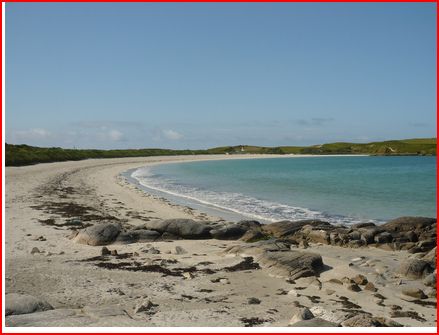
Far from the madding crowd – Dog’s Bay, Connemara
As previously mentioned, foraminifera offered opportunity for eye-catching slides in retail outlets: not perhaps as delicately artistic as the Topping polycystina slides shown earlier in this article, but visually interesting none the less.

Arrangements such as the above doubtless attracted buyers: these three include (I think) an amateur mount on the left, and in the middle a commercial preparer known only by the initials MLS.
Proliferation of affordable books like Wood’s made thousands of enthusiasts familiar with foraminifera, as evidenced by frequent reports in Science Gossip. However, a casual scoop from any pond, riverside or shore pool would more than likely yield some diatoms, but foraminifera were not quite so easy to come by: doubtless this further enhanced sales by professional mounters. More readily obtained were sea urchins, small starfish, and hydrozoa – all favourite subjects for mounting by amateur and professional alike, as evidenced again by large numbers of surviving Victorian slides. Polarised light in Victorian microscopy enhanced the fascination of echinus spines in particular. Interest in microscopic aquatic material was paralleled by the number of books which appeared to satisfy it: some were written by eminent academics, one of the earliest being Professor Harvey’s Sea-side Book (praised by Kingsley although a little too materialistic for his unqualified approval). All in all then, the success of books on aquatic material ensured constant attention from Victorian microscopists, and mounters of all description.
Maritime psychology
For centuries a maritime power, and in Victorian times an aggressively expansive one, Britain had naval exploits engraved on its collective subconscious. If Wellesley was its early nineteenth century hero for his army conquests, Nelson was well-nigh a God, as manifest in his tomb (below) in St. Paul’s cathedral. Wellington’s tomb nearby merely sports lions, but Nelson’s once belonged to Henry the Eighth (intended originally some say for Cardinal Wolseley), and – uniquely – is topped with a crown (well, a coronet anyway).
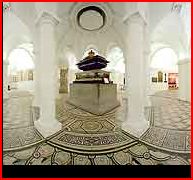
Admiral Nelson’s tomb
Returning to Glaucus: the book contains frequent lyrical asides on the wonders of god’s ingenuity, but Kingsley is (perhaps unconsciously) at his most passionate in another exhortation to study coastal life, worth quoting in extenso:
“Torbay is a place which should be as much endeared to the naturalist as to the patriot and to the artist. We cannot gaze on its blue ring of water, and the great limestone bluffs which bound it to the north and south, without a glow passing through our hearts, as we remember the terrible and glorious pageant which passed by in the glorious July days of 1588, when the Spanish Armada ventured slowly past berry Head, with Elizabeth’s gallant pack of Devon captains (for the London fleet had not yet joined) following fast in its wake, and dashing into the midst of the vast line, undismayed by size and numbers, while their kin and friends stood watching and praying on the cliffs, spectators of Britain’s Salamis”.
The study of aquatic biology, hence by extension the microscopy thereof, was not merely an elevating hobby, but on some quasi-Jungian level a matter of patriotism, and the character of those who undertake it should be, says Kingsley (sic!) like those of knights-errant.
Diatoms again: beauty and usefulness
The Victorian British zeitgeist, probably more so than in other countries, combined concepts of invention and utility with that of beauty, especially under the umbrella of natural theology. Charles Bell’s Bridgewater Treatise on the hand is an archetypal example. The pathologist and curator of the Edinburgh College of Surgeons Museum, J. Bell Pettigrew (piety seems to have been an occupational hazard for surgery in particular) proposed in 1873 that powered heavier than air flight would be an appropriate human attribute. Birds, bats and insects, after all, were beautiful creations by god, who had endowed mankind with the intellectual attributes to work out the details: flight by humans therefore, he reasoned with rabbinical-like confidence, would make man more splendid than in his original state, which would please his creator – and would be not merely a thing of beauty, but extremely useful to boot. Our present “scientific” world view is a lot narrower than anything familiar to Victorians. Charles Darwin may be the materialist darling of Richard Dawkins & co., but many things he wrote would be immediately expunged by today’s print journal referees. Consider this, from his 1842 work on coral reefs:
“….everyone must be struck with astonishment, when he first beholds one of these vast rings of coral-rock, often many leagues in diameter, here and there surmounted by a low verdant island with dazzling white shores, bathed on the outside by the foaming breakers of the ocean, and on the inside surrounding a calm expanse of calm water, which from reflection, is of a bright but pale green colour”.
Today’s editorial Curia would be horrified: all hint of aesthetics, or for that matter humour, is for them irrelevant, and possibly dangerously deluded: proper “scientific” tunnel vision allows only auto da fe for such nonsense. Victorian microscopists, by contrast, saw no conflict between technical study and aesthetic pleasure in another of their favourite occupations, mounting corals and corallines.
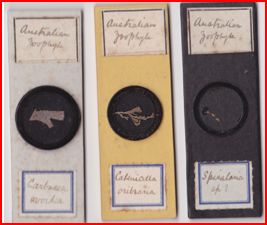
Zoophytes by an unidentified preparer, probably amateur but possibly selling commercially
Amidst the same cluster of ideas, the humble diatom triumphed in theworld of microscopy. Not only did it manifest a fascinating aesthetic variety, it cemented the nexus between beauty and utility by serving as a measure of excellence for the very means which made it visible. When each advance in lens technology arrived – better grinding for higher magnification, correction for chromaticity, binocular facility, polarising prisms and so on – diatoms were used as test objects to gauge the microscope’s capabilities. All major commercial mounters produced slides with this in view, and although other subjects were similarly put forward for this purpose, the diatom probably topped the bill. As yet another pious surgeon, Jabez Hogg, explained,
“In the vicinity of Hull many very interesting varieties have been found, the beauty of which are such as to delight the microscopist; at the same time some of them are highly useful, as forming that class of test objects which are best calculated above all others for determining the excellence and powers of object-glasses” (The Microscope, new edition, p.427).
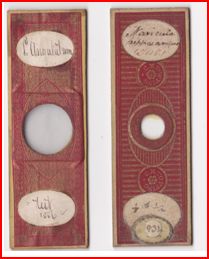
Test slides by Jones and Topping
That pervasive concept of divinely ordained order, the Great Chain of Being, underscored mainstream British Victorian thought: Man (of course) was at the top of the earthly series, and even those who espoused natural selection in reaction against natural theology found it difficult to ditch that. Huxley was successful with his book Man’s Place in Nature: but most, like Lyell, found it difficult to “go the whole orang”. St. George Mivart, trying to reconcile a special and separate place for man with the new evolutionary ideas, ended up vilified by supporters of both sides of the debate.
If man was at the top of the earthly scala naturae, diatoms were presumably somewhere near the bottom: they were nevertheless both beautiful and useful. In the end, they probably outdid other aquatic organisms in capturing attention, simply through their fascinating multiplicity of morphology. Quekett’s mounting-weary preparer, if he turned to diatoms, might well have found that custom could not stale their infinite variety. Certainly, dozens of amateur mounters fell under their spell: and, at minimal expense, pond life, after all, was observable by everybody.
Comments to the author will be welcomed.
Acknowledgement
Rather than undergo the frustrations of antipodean crumbs from the table of Google Books, I have “clipped” the Norman Challenger advertisement from Brian Stevenson’s article on Norman – see his www.microscopist.net
Sources
Oliver Goldsmith, Animated Nature (1840 annotated edition)
Frank Buckland, Curiosities of Natural History, first series
Charles Kingsley, Glaucus
Samuel Smiles, Lives of the Engineers
Philip Gosse, The Ocean, Evenings at the Microscope, & A Year at the Shore
J.G. Wood, Common Objects of the Microscope
Edwin Lankester, Half Hours with the Microscope
Charles Darwin, On the Structure and Distribution of Coral Reefs
Brian Bracegirdle, Microscopical Mounts and Mounters
T.H. Huxley, Oceanic Hydrozoa (Ray Society edition)
Journal of the Postal Microscopical Society, various issues
Science Gossip, various issues
Ernst Haeckel, Kunstformen der Natur
Jabez Hogg, The microscope (new edition,1867)
J. Bell Pettigrew, Animal Locomotion (International Scientific Series,1874)
Microscopy UK Front
Page
Micscape
Magazine
Article
Library
Published in the October 2010 edition of Micscape Magazine.
Please report any Web problems or offer general comments to the Micscape Editor .
Micscape is the on-line monthly magazine of the Microscopy UK website at Microscopy-UK .
© Onview.net Ltd, Microscopy-UK, and all contributors 1995 onwards. All rights reserved. Main site is at www.microscopy-uk.org.uk .